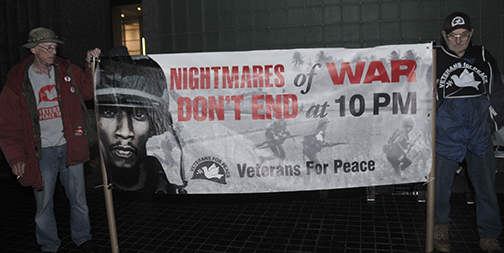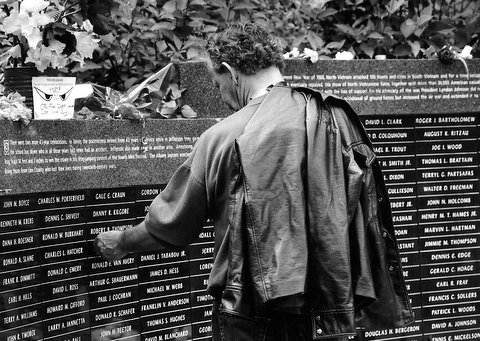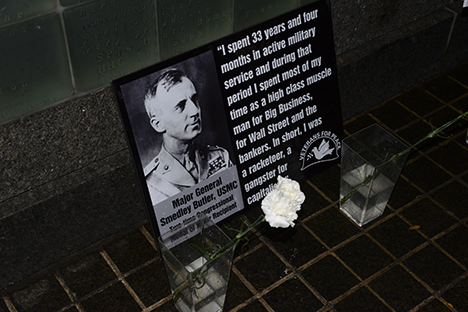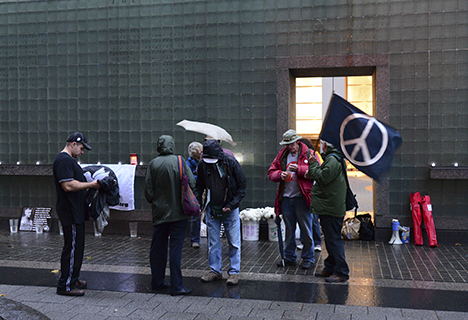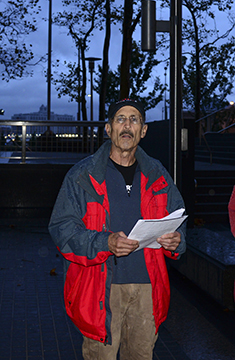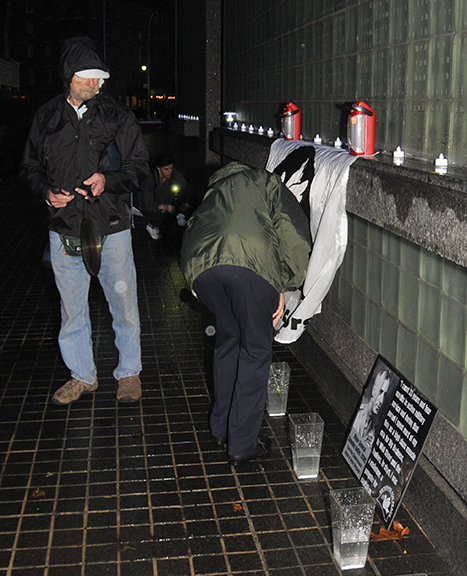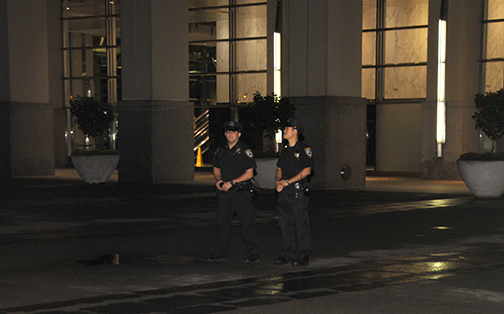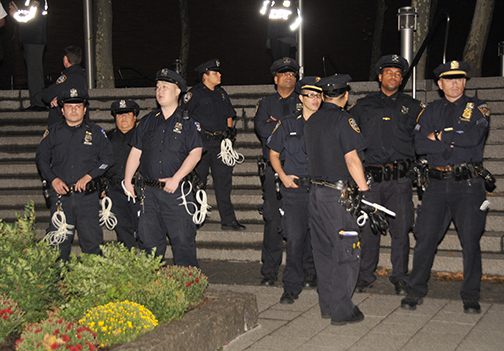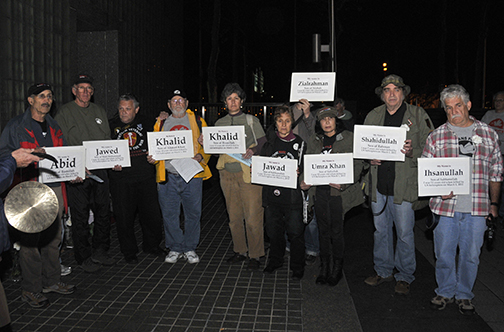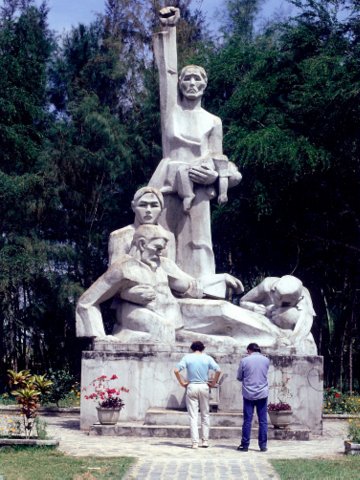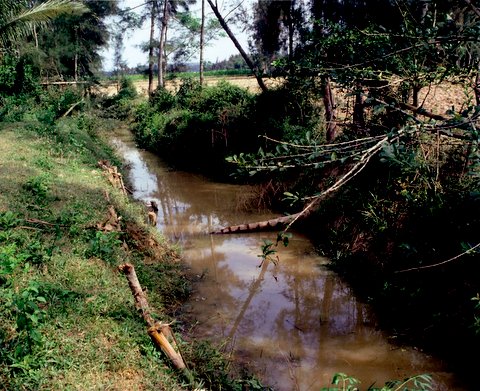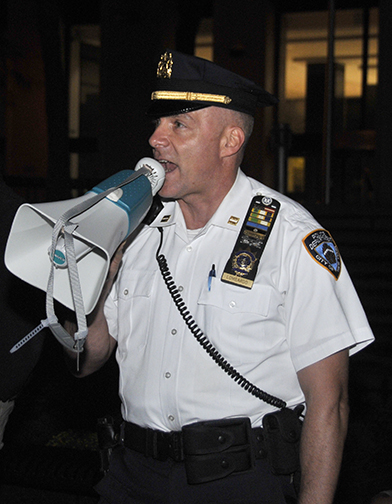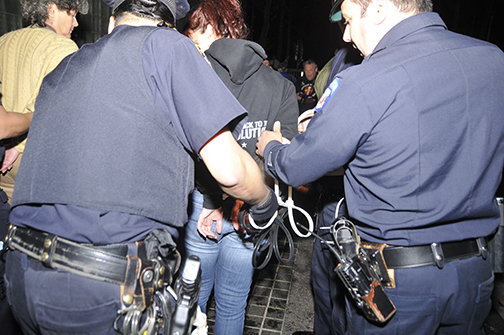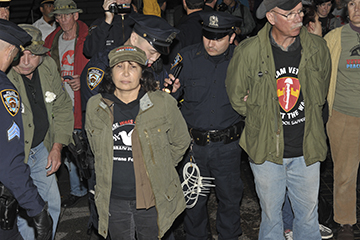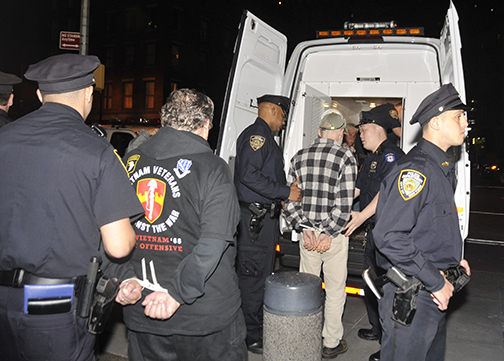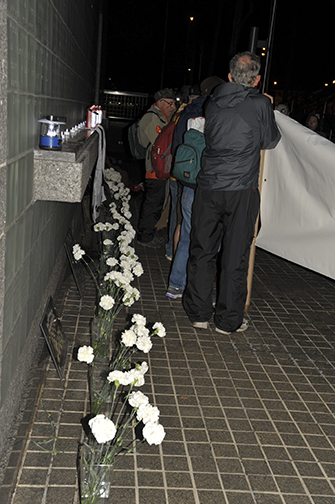By Mike Hastie
Vietnam War combat medic
Video of Mike Hastie speaking to police, 10 pm, Oct. 7, 2013
On the evening of October 7, 2013, Veterans For Peace members and their allies gathered at the Vietnam Veterans Memorial on Water Street in New York City.
Just like last year on this date, we gathered to pay tribute to soldiers who were killed in Vietnam Iraq and Afghanistan. We were also challenging the city’s arbitrary 10:00 pm curfew at the memorial. As veterans and nonveterans, including family members who lost loved ones in those wars, we feel it is our right to visit this memorial at any time of day or night.
Just looking at Americans killed in Vietnam from the state of New York (58,000 nationwide ), there were 1,741 funerals that took place across the state during that war. Family members and friends can visit those gravesites any time day or night, and we feel the same should apply to family, friends and other veterans who come to the Vietnam Veterans Memorial in New York City. This should be a sacred place to express grief, especially if someone wants to grieve alone in silence. It is called privacy.
At the Vietnam Veterans Memorial in Portland, Oregon, or the Vietnam Veterans Memorial in Washington, D.C., and almost all Vietnam Veterans Memorials across America, there is no closing time. Can you imagine asking a Vietnam veteran or a family member to leave at a designated time, telling them they can bring their grief back tomorrow?
I have witnessed people coming to the Vietnam Veterans Memorial in Portland, Oregon, and the memorial in Washington, D.C., late at night. I remember reading a poem written by a Vietnam veteran about seeing the “Wall” for the first time: “I came back as I said I would, to face the pain that I should, only this time the tears will flow, like I couldn’t do years ago.”
We arrive at the memorial at 55 Water Street shortly before 6:00 pm. Within an hour, about 50 people show up, the number increasing as the ceremony progresses into the early evening darkness. October 7 is significant because it marks the 12th anniversary of the start of the Afghanistan War. Or, more correctly, the Afghanistan Occupation.
The first ten people who arrive carry items for the scheduled evening events. I have two cameras and three posters of General Smedley Butler, the recipient of two Congressional Medals of Honor, with his famous statement, “I spent 33 years and 4 months in active military service and during that period I spent most of my time as a high class muscle man for Big Business, for Wall Street and the bankers. In short, I was a racketeer, a gangster for capitalism.” I display the posters against a huge wall made of granite and translucent glass blocks 70 feet long and 16 feet high. When light reflects up against the wall, the color is mint green. On both sides of the memorial are engraved excerpts of letters, poems and diary entries by men and women of all branches of the military service.
Other people carry banners, Veterans For Peace flags, white carnations, vases, songbooks, printed handouts, battery-powered candles, guitars, and pages and pages of names of U.S. soldiers killed in Vietnam, Iraq, and Afghanistan. There is also a long list of Native Americans killed by the U.S. government and names of civilians killed by the U.S. government in Vietnam, Iraq, and Afghanistan.
On one handout is the picture of General Butler with his quote. On the back is written:
“We are veterans and allies who stand for
1. An end to the 12-year war in Afghanistan
2. An end to all U.S. wars of aggression
3. Our right to remember those who have been killed or wounded by war
4. Our right and duty to assemble and organize.”
We recognize the immediate and long-lasting effects of war, both here at home and where it happens—death, destruction, permanent injury and trauma to those in the war zone. We stand for our right to assemble to address those very specific grievances at the Vietnam Veterans Memorial and elsewhere. We do not forget that 22 American veterans commit suicide every day, nor the fact that one active duty soldier commits suicide every single day, and those who have been killed or wounded in every war for profit by the American empire’s corporate ruling class, including the ongoing 500-year genocidal war on our Native American brothers and sisters.”
On another handout is a bold headlinethat reads, “UNARMED TRUTH—SILENCE IS BETRAYAL” and a quote by Vietnam Veteran Paul Appell: “Some of us are not going away at 10:00 pm, or any other time. If they do not like it, maybe they should have thought of that before they sent us to war.”
The ceremony starts out with Tarak Kauff reading the names of Vietnamese civilians killed in the war. The Vietnamese called it “The American War.” That is followed by Carol Ezell reading names of Native Americans killed by the U.S. government. And on it goes, as people step forward, veterans and nonveterans, to read the names of soldiers who were killed in Vietnam, Iraq, and Afghanistan. Page after page after page of the dead who died in wars of aggression for the corporate gangsters of American capitalism, as General Butler so succinctly stated.
As I take pictures and listen to the somber roll call, I think of the powerful statement by Dalton Trumbo, from his classic novel, Johnny Got His Gun: “If the thing they were fighting for was important enough to die for then it was also important enough for them to be thinking about it in the last minutes of their lives. That stood to reason. Life is awfully important so if you’ve given it away you’d ought to think with all your mind in the last moments of your life about the thing you traded it for. So did all those kids die thinking of democracy and freedom and liberty and honor and the safety of the home and the stars and stripes forever? You’re goddamn right they didn’t.”
Then the scheduled speakers begin to bear witness. They are passionate about why they are here and their commitment to exposing the deceits of U.S. foreign policy. Lying is the most powerful weapon in war, and the speakers relate their own experiences involving that truth. After each speaker finishes, they read the names of the dead, slaughtered by U.S. colonialism and greed. After each 20 names, a gong is sounded and a white carnation placed in one of 12 vases on the ground to mark the 12 years of the Afghanistan War. A momentum is building, energy that all of us can feel, as name after name is read. As a photographer, I see the somber faces of peacemakers resurrecting the truth of what they feel in their hearts. They have become global citizens with compassion for their fellow human beings around the world.
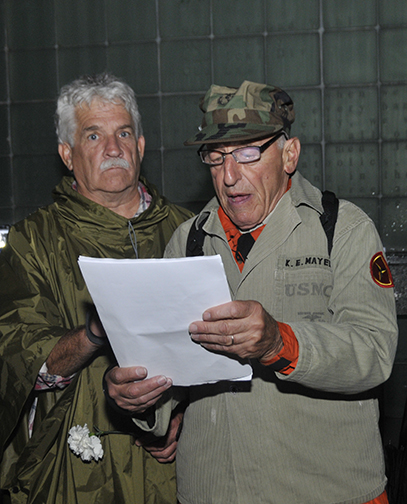
Navy veteran Mike Tork holds the light while Marine Major Ken Mayers reads names. Photo by ELLEN DAVIDSON
Governments create enemies, not global citizens. The ruling class has done this since the beginning of wars. Blinded by the glory of power and wealth, the corporate rich who make billions of dollars off of war profiteering seldom send their own children to war. When I was in Vietnam, I never met a fellow soldier who came from a wealthy family. Most of us came from working-class, and poor families.
And the names of the dead continue to be read: Robert Bailey Markum, Thomas William Markunas, James Edward Marlow, Joseph Vieto Marrone, Tyrone Cecil Marsden, David Joseph Marsh, Eddie Lester Marshall, Albert Martin, Anthony Vincent Martinez, Kenneth Henry Mashlykin, John George Masinski, Harold Mason Jr., Johnnie Mason, James Joseph Masotti, Luis Alberto Massa, Peter David Matarazzo. …
An hour into the ceremony, the police begin to show up. Only a few at first, as they take their stations on the upper ledges of the plaza facing the memorial. It is not quite 7:00 pm, and we wonder why they have shown up so early, three hours from the 10:00 pm curfew. One is wearing a white shirt with captain’s bars, no doubt in charge of this operation. He is physically buff, with a swagger, and paces back and forth. I was raised by a World War II career military officer, so I am familiar with his demeanor. As far as I can tell, it makes no difference that most of us are veterans. He has a job to do, and obedience is the name of the game here. Briefly, I feel like I am back in basic training.
And so it goes, as we stare at them, and they stare at us. More police show up, many with white plastic handcuffs hanging from their belts.
I have seen this many times before, as the police make a show of force. They know we are nonviolent, so none of them have riot gear on. We are Vietnam, WWII, Iraq, and Afghanistan veterans and supporters at a Vietnam Veterans Memorial, conducting a sacred ceremony for the dead, and for some reason after 10:00 pm that is against the law. I wonder if there is a curfew at the memorial for the first responders killed on September 11, 2001.
One of our group is an 87-year-old World War II combat veteran who saw a lot of death in Europe. He helped liberate three concentration camps. One of the 19 arrestees, he will spend 21 hours in jail, where he will be photographed and fingerprinted, and will go on trial, we hope before a jury, as the charges mandate. He was arrested last year for the same thing—an 87-year-old peacemaker, trying to stop the madness, because he has seen the madness. His name is Jay Wenk.
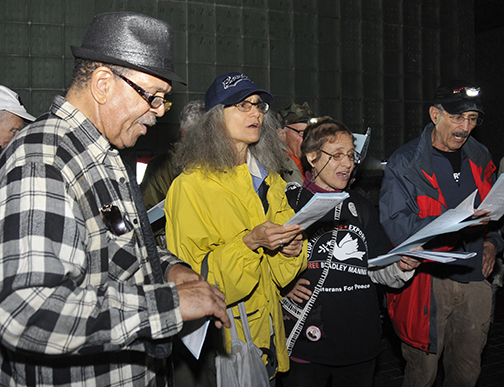
Veteran Don Raphael, Raging Grannies Adele Rolider and Alice Sutter and VFP member Tarak Kauff. Photo by ELLEN DAVIDSON
As it gets darker, we take a break from reading names to sing from a printed songbook with songs such as “Feel Like I’m Fixin’ to Die Rag,” and “This Land Is Your Land.”
After the songs lift our spirits, we go back to reading the names of soldiers killed from the state of New York. By now we have read close to a thousand names. On and on we go through the late evening, as the 10:00 pm curfew gets closer. At one point, several peacemakers hold up large cards with the names of civilians killed in Afghanistan. I take a picture of ninepeople holding up the names. There is Abid 10, Jawed 11, Khalid 10, Khalid 13, Umrakhan 10, Zialrahman 12, Shahidullah 7, Ihsanullah 11, and two others. They were children, all killed by U.S. helicopters.
***
In Vietnam, U.S. weapons killed thousands of Vietnamese children, and tens of thousands were made orphans. When you include Laos and Cambodia, the figures are staggering.
The most painful experience I had when I went back to Vietnam in 1994 was going to the My Lai Massacre site in Quang Ngai Province. On March 16, 1968, U.S. soldiers murdered 504 Vietnamese civilians in this village. This was a U.S. military operation, not something that went drastically wrong. The My Lai Massacre is a metaphor for the entire Vietnam War. Quang Ngai Province was known as a Viet Cong stronghold, site of many ambushes involving U.S. troops. The military’s goal was to leave a deadly calling card, terrorizing the entire province. If combatants are like fish in a lake, and the water represents the civilian population supporting those fighters, the way to stop that is to drain the lake.
Being at the site of the slaughter was psychically numbing. I took photographs of a large drainage ditch where Lt. William Calley and his soldiers herded about 150 Vietnamese civilians and shot them at pointblank range. We went through the war crimes museum there. When we left after four hours, not one word was spoken between us during the 30 minutes it took to get back to our hotel. The overwhelming emotion was a profound sense of shame at being an American citizen.
If anyone doubts the horror that the U.S. government inflicted on the Vietnamese people, just read Nick Turse’s recent book, Kill Anything That Moves—The Real American War in Vietnam. Read what the Vietnamese have to say about the American War. Read this until it breaks your heart. That is when you become a global citizen, and you begin to bear witness about the American Empire.
The lie of the Vietnam War, of the Iraq War, and of the Afghanistan War is so powerful that in order to survive, the veteran has to re-define his or her life. That deep feeling of trust is executed. More Vietnam veterans have committed suicide than were killed in Vietnam. That patriotic world they once trusted is no longer there. When they try to explain this to their family, to mental health providers, they get no validation. They feel like strangers in their own country.
In 1977, I read The Survivor by Terrence Des Pres. A short paragraph from that book gave me a profound insight into my own PTSD: “The survivor, then, is a disturber of the peace. He is a runner of the blockade men erect against knowledge of unspeakable things. About these he aims to speak, and in so doing he undermines, without intending to, the validity of existing norms. He is a genuine transgressor, and here he is made to feel real guilt. The world to which he appeals does not admit him, and since he has looked to this world as the source of moral order, he begins to doubt himself. And that is not the end, for now his guilt is doubled by betrayal—of himself, of his task, of his vow to the dead. The final guilt is not to bear witness. The survivor’s worst torment is not to be able to speak.”
***
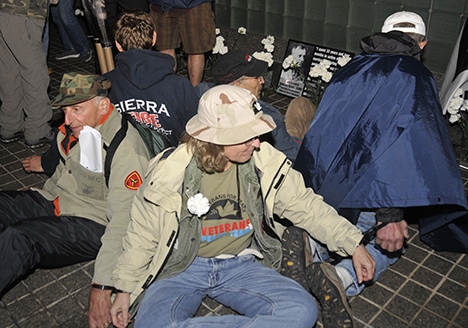
Veterans Ellen Barfield, Jay Wenk, Tarak Kauff, Micah Turner, and Ken Mayers. Photo by ELLEN DAVIDSON
At around 9:30 pm on Oct.7 at the Vietnam Veterans Memorial, five members of Veterans For Peace link themselves together with black plastic handcuffs and lie in a circle at the base of the memorial, symbolizing the interconnectedness and finality by death of children, mothers, fathers, Native Americans, and American soldiers from U.S. wars of empire. Members of our close group keep reading the names of the dead, and after 20 names are read, the gong sounds, and another white carnation is placed in a vase. The 12 vases are beginning to fill up.
Around 9:45 pm, the police captain announces over a megaphone that we are required by law to vacate the memorial park or risk arrest. He adds that those who handcuff themselves together will be charged with resisting arrest. By this time, there are about 25 officers gathered in the plaza, some in civilian clothes with their badges displayed. One has a video camera. You can feel the tension on both sides, especially with our group of around 60. Many veterans are wearing their field jackets, with unit patches on their arms. You can see the seriousness on our faces as we prepare for a long night of being handcuffed, put in police wagons, and driven to jail. Most of us are feeling yet another betrayal by our government. We are military veterans and nonveteran peacemakers being arrested at a Vietnam Veterans Memorial during a sacred ceremony honoring our fellow soldiers and civilians killed in Vietnam, Iraq, and Afghanistan, as well as Native Americans killed by the U.S. government.
A few minutes before 10:00 pm, I step forward and tell a group of police officers why we are there. For some reason, I am compelled to deliver this message; I simply have to explain why I personally chose to challenge the curfew. I want them to know their history, even though most of them were born after the Vietnam War. This is what I said, caught on video: “It’s just important that you know why we’re here. This monument belongs to us. This is a Vietnam Veterans Memorial. Twenty-two veterans commit suicide every single day. It’s important you know that your government committed immense atrocities during the Vietnam War. We did it every day. It’s just important you know that, because some of you are so much younger, and that history has been denied you.”
Shortly afterward, the police captain announces on the megaphone that his officers will commence arresting people, and those who decide not to be arrested are to gather on the other side of the memorial. The officers start to handcuff those who stay. I was arrested last year for the same reasons, but this time the organizers want me to photograph the arrests. So that is what I do over the course of about 30 minutes. I duck in and out of the other side of the memorial, to let the police know that I am going to comply, but at the same time I am taking pictures. And so it goes, as arrest after arrest is made.
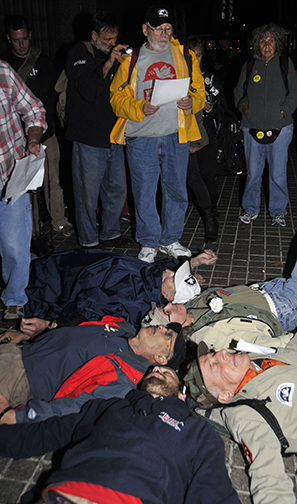
Veteran John Spitzberg reads names while Tarak Kauff, Jay Wenk, Ellen Barfield, Ken Mayers, and Micah Turner lie handcuffed together. Photo by ELLEN DAVIDSON
During all this time, someone continues to read the names of the dead: Alfred Lee Stonehouse, Daniel John Sullivan, Raymond Peter Susi, Robert Joseph Tarranto, Jose Rafael Tavarez, Malone Bennett Temple, Daniel Thomas, Alfred Timms, Stanley Richard Tokarski, Santiago Torres Jr, Jesus M. Torres, Cyril Harris Townley, Willie George Turner, Eddie Vasquez, Fredrick Thomas Williams, Robert John Williams …
The faces in the pictures of those being arrested are somber. They are on the receiving end of injustice. They are all betrayed by the arbitrary decision to enforce the curfew law. But, more important, how would the dead soldiers have felt, watching us being arrested? What would they have said to the arresting police officers? It is our moral responsibility to speak for the dead.
A handcuffed women looks at me with tears in her eyes and says, “I can’t believe they are arresting us.”
I continue to take pictures as the arresting officers walk people to the waiting police vans, sit them inside and put on their seatbelts. The five lying on the ground linked by plastic handcuffs are the last arrested. Just before each handcuffed person enters the van, his or her picture is taken. When all 19 are in the vans, the doors are locked, and they are driven away.
I am standing with one of the organizers as the vans drive away when I hear my name being called. It is the police captain with the white shirt. He says he wants to talk to me, so we walk a few feet away. I know exactly what is going to happen. This is going to be a parent-child conversation. I can see it in his facial expression and his body language. He is going to cut me down to size. Little does he know, I am very familiar with these kinds of power tactics. I know officer behavior very well, as it is all the same obedient language. I was taking orders from a World War II combat Army officer before this captain was born.
When we stop, this is what he says, “I just want you to know that I heard what you said to my police officers. I do not appreciate you diverting my police officers’ attention as they were carrying out their duties.” His thick arms are crossed in front of him, and I guess he expects me to make some kind of apology. I look at him and say, “You have got to be kidding me. In case you didn’t know, that is called free speech, and your police officers had every right not to listen to me. But I think they did.”
I am sure that was not the response he wanted to hear. He looks at me and says, “Now, I want you to leave the premises, as this park is closed.” As he is walking away, I say to my friend, so the captain can hear me: “Well, I guess I just got betrayed again, just like in Vietnam.”

